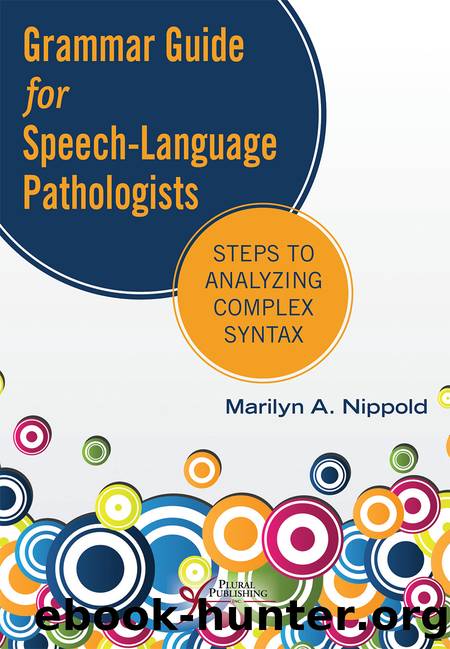Grammar Guide for Speech-Language Pathologists: Steps to Analyzing Complex Syntax by Marilyn A. Nippold;

Author:Marilyn A. Nippold;
Language: eng
Format: epub
Publisher: Plural Publishing Inc.
Nonfinite Clauses
In contrast to finite subordinate clauses, nonfinite clauses are not marked for person, number, or tense. Rather, they always occur in the same, unchanged form. They include infinitives (e.g., to run, to play, to jump, to help, to take), gerundives (e.g., running, playing, jumping, helping, taking), and participial clauses (e.g., striking, displaying, evaluating). Letâs discuss each one.
Infinitive Clauses
An infinitive clause contains an infinitive verb preceded by to, as in âBill wants to run the marathon,â âJake likes to eat all the frosting,â and âDavid prefers to do the cooking.â In these examples, the subject of the main clause (Bill, Jake, David) is the same as the subject of the infinitive clause. Sometimes, however, the subject of the main clause differs from that of the infinitive clause. For example, in âLet the dog eat his dinner,â you is the unstated subject of the main clause and dog is the unstated subject of the infinitive clause. The subject of the main clause has been omitted because, as an imperative sentence, the subject is understood; in contrast, the subject of the subordinate clause (dog) has been omitted to avoid redundancy.
Infinitive clauses are an early-emerging type of subordinate clause, often preceded in development by the use of catenatives such as hafta, wanna, lemme, and gonna. Catenatives are contracted forms of a main verb (e.g., have, want, let, going) and the to part of an infinitive verb (e.g., to leave, to see, to do, to run). For example, a speaker might say, âI hafta leaveâ (âI have to leaveâ), âI wanna see itâ (âI want to see itâ), âLemme do itâ (âLet me do itâ), or âSheâs gonna runâ (âShe is going to runâ). When very young children produce utterances such as âI hafta seeâ or âI wanna do it,â catenatives are considered to be unanalyzed wholes that do not reflect the use of complex syntax; rather, they are considered to be components of simple sentences (Paul, 1981). But once the child begins using infinitive verbs in their expanded forms (e.g., âIâll get the book for you to read tonightâ; âJamie wants to sit in Grammaâs swingâ), those are full-fledged infinitive clauses, making the sentence complex. Itâs also important to remember that sometimes the to element in an infinitive clause is omitted, especially when preceded by the main verbs help, let, make, or watch (Paul, 1981). For example, to is omitted in the following sentences:
Iâll help you [to] bake the cake.
Let me [to] take it out of the oven.
Bobby will make the airplane [to] land on the runway.
Did you watch Toby [to] slide down the snowy hillside?
Exercise 8â6
In the following complex sentences, underline all of the infinitive clauses. Some sentences may have more than one infinitive clause. Then check your answers on pp. 221â222.
1. Paul likes to eat oatmeal for breakfast every morning.
2. Please allow the cat to go outside if she decides to scratch the screen.
3. Do you know how to play croquet?
4. Tell me when you want to start learning the game.
5. Iâll make the puppets talk in squeaky voices.
Download
This site does not store any files on its server. We only index and link to content provided by other sites. Please contact the content providers to delete copyright contents if any and email us, we'll remove relevant links or contents immediately.
| Administration & Medicine Economics | Allied Health Professions |
| Basic Sciences | Dentistry |
| History | Medical Informatics |
| Medicine | Nursing |
| Pharmacology | Psychology |
| Research | Veterinary Medicine |
Machine Learning at Scale with H2O by Gregory Keys | David Whiting(2342)
Fairy Tale by Stephen King(2113)
Will by Will Smith(2093)
Hooked: A Dark, Contemporary Romance (Never After Series) by Emily McIntire(2023)
Rationality by Steven Pinker(1789)
Friends, Lovers, and the Big Terrible Thing by Matthew Perry(1362)
The Becoming by Nora Roberts(1352)
A Short History of War by Jeremy Black(1316)
The Strength In Our Scars by Bianca Sparacino(1305)
HBR's 10 Must Reads 2022 by Harvard Business Review(1269)
515945210 by Unknown(1221)
Love on the Brain by Ali Hazelwood(1145)
Fear No Evil by James Patterson(1125)
Bewilderment by Richard Powers(1092)
443319537 by Unknown(1084)
The Real Anthony Fauci: Bill Gates, Big Pharma, and the Global War on Democracy and Public Health (Childrenâs Health Defense) by Robert F. Kennedy(1074)
The Psychiatric-Mental Health Nurse Practitioner Certification Review Manual by Zakhari Raymond DNP EdM ANP-BC FNP-BC PMHNP-BC;(1070)
Leviathan Falls (The Expanse Book 9) by James S. A. Corey(1063)
Works by Richard Wright(1028)
